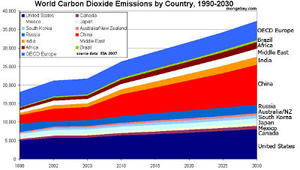ClimateGlobal carbon emissions at record high
Global carbon emissions are at their highest ever levels, increasing fears of a global temperature rise over the “dangerous” two degrees Celsius threshold; unpublished estimates from the International Energy Agency revealed that the world economy’s return to growth in 2010 coincided with a 1.6 gigaton rise in carbon dioxide emissions, the highest ever recorded jump

Projected emissions growth puts China in the lead // Source: mongabay.com
Unpublished estimates from the International Energy Agency revealed that the world economy’s return to growth in 2010 coincided with a 1.6 gigaton rise in carbon dioxide emissions, the highest ever recorded jump.
“This is the worst news on emission,” IEA chief economist Faith Birol told the Guardian.
“It is becoming extremely challenging to remain below two degrees”, he added. “The prospect is getting bleaker. That is what the numbers say.” AFP reports that scientists believe that a temperature rise of more than two degrees Celsius would represent “dangerous climate change”.
The IEA has warned that annual energy-related emissions should be no higher than 32 gigaton by 2020. The latest figures estimate that 30.6 gigaton of carbon dioxide were emitted in 2010 — a rise of 1.6 gigaton on 2009.
Nicholas Stern of the London School of Economics, the author of an influential report into the economics of climate change, predicted dire consequences unless emissions were reined in. “These figures indicate that (emissions) are now close to being back on a ‘business as usual’ path,” he told the Guardian.
“According to… projections, such a path … would mean around a 50 percent chance of a rise in global average temperature of more than 4C by 2100,” he added. “Such warming would disrupt the lives and livelihoods of hundreds of millions of people across the planet, leading to widespread mass migration and conflict,” he added.
Around three-quarters of the rise was attributed to emerging economies.
The Guardian notes that there are other factors that made it even less likely that the world would soon meet greenhouse gas reduction targets:
The IEA found that about 80 percent of the power stations likely to be in use in 2020 are either already built or under construction. Most of these are fossil fuel power stations unlikely to be taken out of service early, so they will continue to pour out carbon, possibly into the mid-century. The emissions from these stations amount to about 11.2 gigaton, out of a total of 13.7 gigaton from the electricity sector. “These ‘locked-in’ emissions mean savings must be found elsewhere,” the paper says.
The crisis in the nuclear power industry. Following the tsunami damage at Fukushima, Japan and Germany have called a halt to their reactor programs, and other countries are reconsidering nuclear power.
The UN-led negotiations on a new global treaty on climate change have stalled.